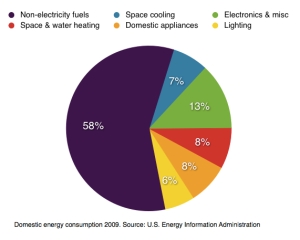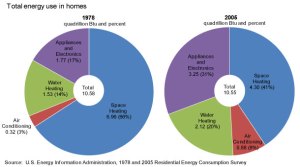Possibly not as much as you may have been led to believe. But decide for yourself with the official government data from my newly updated Energy Statistics post:
A. The residential sector (private households) total energy consumption is 12% of total delivered U.S. energy.
B. Of total delivered energy to the residential sector, 58% comes from various fuels (oil, kerosene, natural gas, renewable etc) and most is used for space heating. The remaining 42% comes from electricity and is split as follows (my own pie chart, from two different EIA ingredients):
C. Lighting uses around 15% of household electricity and 6% of total household energy consumption.
D. If all household lamps were incandescent, the replacement bulb might save (depending on what type and quality of lamps one replaces them with, how often and how long they are used, how long they last etc) 25 -75% = 1.5 to 4.5% (optimistically) of total household energy consumption.
E. But not all household lamps are incandescent since many have already switched to CFL or LED, and already had about 5% linear fluorescent lamps. According to a July 2011 Energy Star report, CFLs accounted for nearly 28 percent of all residential light bulb sales. This leaves 67% standard incandescent. Of which not all are suitable for replacement (e.g. in bathrooms, hallways, in small or antique luminaires or luminaires designed specifically for halogen or LED etc). So, say 50% left that could be switched = 0.75 to 2.25% potential savings savings of average total home energy use (could be more or less in any individual household).
This is not a lot, is it? True that every little bit counts, and any little bit that can be saved is for good of everyone. But at what cost?
I. The first cost is light quality.
• CFLs have a Color Rendering Index of 82-85. This means you get a duller light and won’t be able to see colours as well. A simple trading of quality for quantity, just like in the office. If you don’t mind that in your home, that’s fine then.
• LED quality can vary widely between manufacturers. LED lamps have CRI of 75-92. They often reflect more of the spectrum, but the light color can still be off and it will lack the vibrancy of incandescent light.
• Halogen Energy Savers will save less (25-30%) but give top quality light with perfect color rendering capacity, as it is also a form of incandescent light.
II. The second trade-off is health & safety.
• CFLs contain small amounts of highly toxic mercury vapor and should never be used around children, pets or pregnant women, in case they break. There are silicon-covered bulbs on the market that don’t shatter as easily, but most don’t have that protection. All CLFs must be recycled safely and never thrown in the trash. Some CFLs also emit some UV-radiation at close range. May not be enough to pose much of a risk to a healthy person unless used very close for prolonged periods of time, but persons with UV-sensitive conditions may have adverse reactions.
• LEDs have been shown not to be quite as green and non-toxic as assumed either, but probably safer than CFLs.
• Incandescent lamps, including halogen, contain no toxins and pose no known health risks.
So, why go after the tiny portion that is used for lightings pecifically, while we keep using more and more other electrical gadgets? A chart from the EIA page Share of energy used by appliances and consumer electronics increases in U.S. homes shows how the electronics pie slice has grown to almost twice its size since the 1970s:
Isn’t it interesting also that the total household energy use has hardly changed since 1978 (!) while the proportions of how that energy is spent has changed dramatically? This seems to me pretty solid proof of the often-scoffed-at Jevons paradox and may pose more risks when switching to energy saving lighting.
1. The first is that one may feels one has done so much for the environment that not much more needs to be done. This impression is enhanced by the fact that the switch may make a big change in a room’s apperance (and not always to the better) and by the fact that CFLs have been promoted by everyone, from gazillions of bloggers and journalists to state presidents as the one thing that will make a difference. (And they in turn have been targets of two decades of multi-million dollar lobbying to make them belive that.)
2. The second is that since one belives one is saving so much on the lights, one can leave them on for a bit longer. An article comment illustrates this sentiment well:
“My dad switched to CFLs, but now he just leaves the lights on all the time because he says ‘they use so little power, I can’t be bothered to turn them off’.”
3. Many CFLs are also supposed to be turned on for 15 minutes to 3 hours at a time in order not to shorten their life dramatically.
But if you still want to save a little, and if you opt for the least less energy saving but non-toxic, top quality halogen lamp, you can easily save the remaining 1.5% by turning the heating or cooling down a degree or two, taking shorter showers, skipping coffee & toast, using dimmers and turning lights off when you leave the room and still have a green conscience.


GeorgeR said,
May 9, 2012 at 4:37 pm
Incandescent lamps do contain hazardous material – moreso in the USA than in Europe where they are a bit more serious about ROHS. The list of hazardous materials is long but includes lead, cadmium, chromium, barium, mercury and tungsten. The only reason these lamps are sold and, worse, able to be placed in the normal waste stream is because of various statutory exemptions. Even in the US, high volume users of incandescent bulbs are required to divert them from the general waste stream. And because they don’t last so long, the accumulated hazardous waste per lumen-hour of lighting is high.
If you’re going to cry about power factor, don’t be using phase-fired dimmers .. duh. In any case, better electronic ballasts are PFC type anyway.
halogenica said,
May 9, 2012 at 5:34 pm
Really? I assume you have some kind of proof of this claim?
In Europe, lead was removed from incandescent lamps 2005 (if I remember correctly).
You have a point about the dimmers.